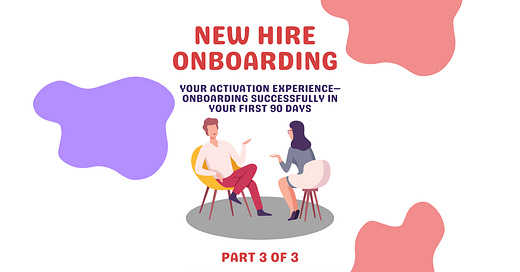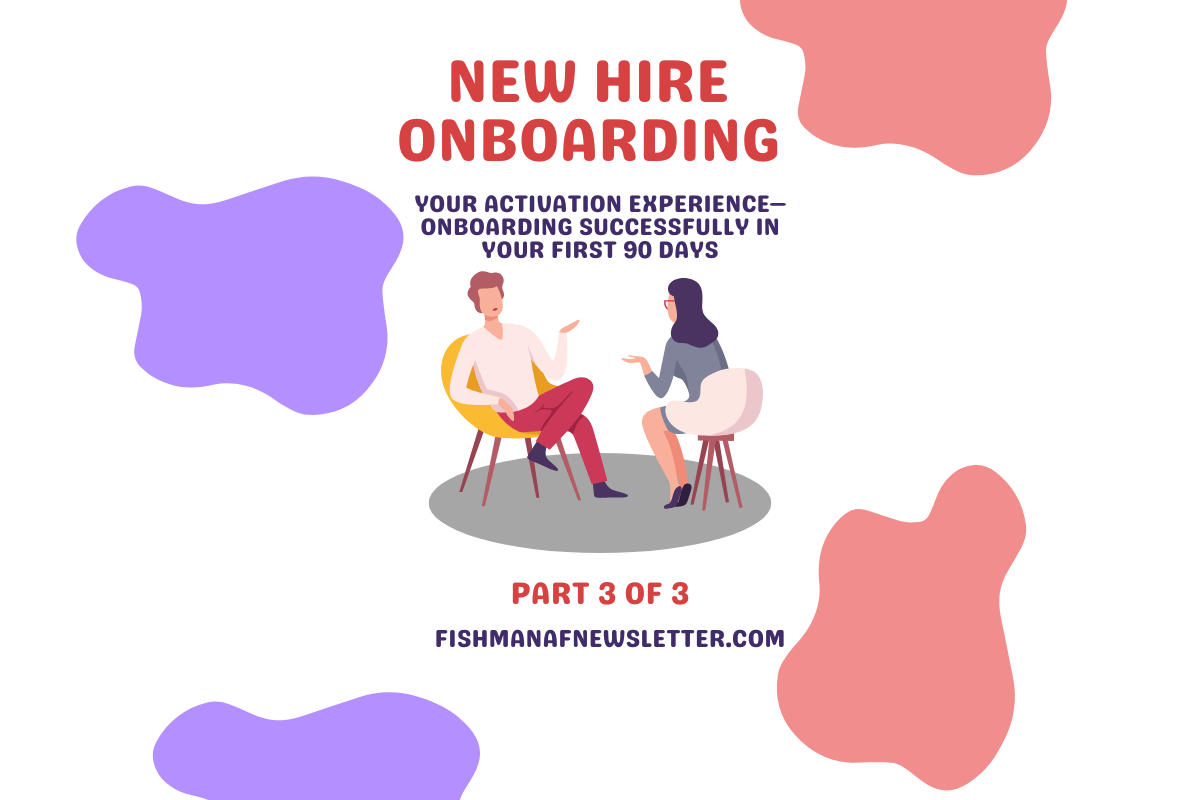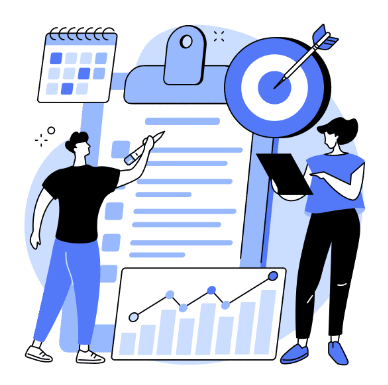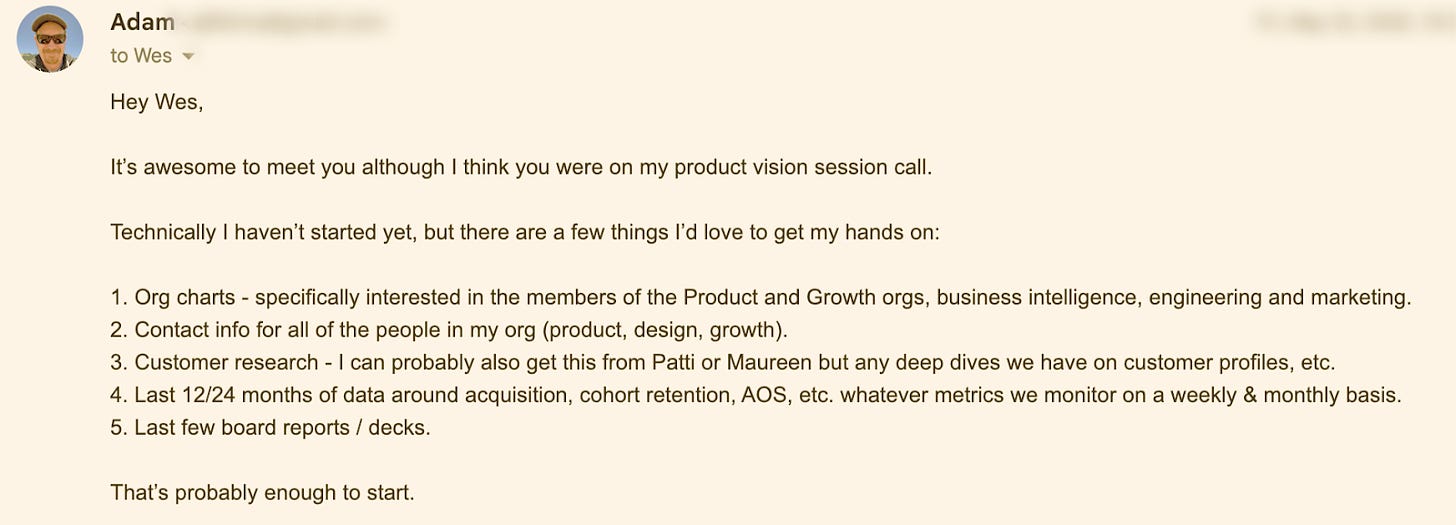Your Activation Experience—Onboarding successfully in your first 90 days
Part 3 of a 3-part series on how to successfully join a new company; featuring lessons and templates from Change.org, Kumu, Spotify, Tile, Super, US Digital Response and more
Hi there, it’s Adam. 🤗 Welcome to my weekly newsletter. I started this newsletter to provide a no-bullshit, guided approach to solving some of the hardest problems for people and companies. That includes Growth, Product, company building and parenting while working. Subscribe and never miss an issue. Questions? Ask them here.
Note: I’m taking a short vacation so probably won’t have a new post next week. If you’re mad about that just remember it’s a free newsletter.
This is the final post in a three-part series exploring how to successfully join a new company. In my last series I described the hiring experience—specifically for making your first Growth hire. With the continued layoff crunch in the tech world and a job market flush with great talent it’s important for candidates to understand how best to identify, choose, and onboard successfully to their next role.
Part 1: The New PMF—A Candidate Framework for Company Selection and Evaluation
Part 2: Reverse Interviewing—How to interview a company as well as they interview you
Part 3: Your Activation Experience—Onboarding successfully in your first 90 days ⬅️ you are here
In The New PMF I identified ways to evaluate across the dimensions of People, Mission, and Financials. In Reverse Interviewing I provided a template for organizing your reverse interviews, interview questions across culture, strategy, goal-setting, role, expectations and communication as well as a process to identify your non-negotiables.
This post is an exploration of how to build a bulletproof onboarding plan for yourself, including what to prioritize and how to align with your manager. I asked some of the onboarding phenoms in my network for their frameworks and advice and I’ve captured their responses here.
In today’s post I’ll cover:
Why it’s important to focus on your own onboarding plan
How to create and organize your plan
Aligning with your new boss
Onboarding lessons and approaches from successful leaders
Templates you can use right now
Why Build Your Own Onboarding Plan
If you’ve followed my advice up to this point you’ve found a fantastic, new company and negotiated an equally fantastic job offer. You’re confident you’ve picked the right next place. Everyone is ready for your big start date and you’re going to “hit the ground running” as the cliche suggests. What could possibly go wrong?
Everything.
You’ll be running into a few headwinds when you get started and the strength of those headwinds can vary wildly by company.
Headwind 1: underdeveloped company onboarding experience.
Most companies, especially startups, don’t have a robust onboarding experience. You’re lucky if you get a laptop shipped to you on time and if the company swag fits properly. Maybe your manager has set you up with a handful of “meet-and-greet” conversations but you won’t know what those people do or how they can help you.
Headwind 2: remote first makes relationship building harder.
For all the benefits we’ve realized from a remote and distributed workforce it’s still hard to have coffee or lunch with a new co-worker who lives in a different state (or continent). What was the #1 piece of peer relationship-building advice I read about in researching this post? Meet in person. Gee. Thanks.
Headwind 3: you’re no longer the top priority
You may have been the most important person during the interview process but get ready to be taken down a few notches. You’re a co-worker now and your co-workers have their own set of priorities, OKRs, and performance goals. Unless they’re your manager (and possibly not even then) I wouldn’t expect “onboard you successfully” to be at the top of the list.
Just as a poorly onboarded new customer has a low likelihood of retention so too does a poorly onboarded new employee. And yes, it should be the company’s job to ensure your onboarding success. The problem is that nearly 90% of companies don’t do employee onboarding well.
If you want to be happy and successful in your new role you’ve got to take matters into your own hands. Building your own onboarding plan helps you push past those headwinds – you’ll define success and expectations, build relationships, and set yourself up for great long-term retention.
Creating and Organizing Your Plan
Building your onboarding plan can take a variety of shapes, but there is one constant: “quick wins.” Ask one hundred people about what matters in a new role and they’ll say quick wins. Ask those same hundred people to define a quick win and you’ll probably be met with blank stares.
The quick win is the hallmark achievement of a new hire and yet we struggle to define and achieve them. A quick win for an individual product manager could look very different than a director of product.
A quick win is:
Visible
Impactful
Achieved repeatedly within your first ~90 days on the job
Your onboarding plan delivers the inputs that lead to the quick win. This matters because the quick win is what creates organizational confidence (with your boss, your peers and your team) that you were the right hire for the job. Think of it as their “aha moment” about you.
There are five key components to a successful onboarding plan:
Pre-work / research
Objectives & Goals
Strategic Themes
Tactics
Deliverables
Doa Jafri, Operator in Residence at Reforge, fractional CTO at Super, and cool Web site builder, talks about the elements of great onboarding:
“A good onboarding answers these questions: What is our goal as a team? Where do I fit into that goal? What areas will I eventually own? Who are the stakeholders I should start building relationships with? What are my 30 / 60 / 90 / 180 goals? How do I get set up? Where do I go when I need help? How can I get to be part of the company culture? This excludes all the onboarding ops questions (benefits, pay, accounts access, etc.).”
Pre-work / research
If you were trying to build a new product you’d start with some research. Your onboarding journey is no different except your “customers” are your future co-workers.
The type of research you do will vary by the role and how much you learned during the interview process. At a minimum, you’ll want to understand:
Customer research
Org charts and team structure
Existing processes
Strategy (company, product, [your functional area])
The best people I’ve ever worked with ask for this information up front before their start date. You should too. This is because the information and cultural overload associated with joining a new company can be exhausting and the more you can gather and process ahead of time the better. This also enables you to make better use of the initial conversations you have with your teammates when you join.
Erika Warren, Head of Growth at Change.org, put it best:
“I underestimated the social exhaustion of being new, particularly in remote settings. When you're still learning the culture, and you're new, you don't want to make the wrong first impression. And you're meeting new people, or in a new situation, every day, for a long time. Sort of like meeting your partner's parents or friends, it's less nerves, and just a lot of extra care and thought that goes into communicating.”
It’s also really important to understand what sort of situation you’re walking into. If you followed my advice you did this during the interview, reference and backchannel process. If not, that’s okay, I accept your apology and forgive you.
Camille Hearst, Head of Spotify for Artists and a former colleague of mine at Patreon has made this a priority in the past:
“It’s important to know what situation you’re entering in when you join a new company. You could be joining a company in need of a turnaround, growth, restructuring, or something in between. Knowing this helps you know what questions to ask and how to navigate the org.”
Here’s an example of the email I sent the Imperfect Foods team before I joined as Chief Product and Growth Officer.
Objectives & Goals
You’ll want to match your objectives to the strategy, the expectations of the role, and the expectations of your manager around goals and timelines. Not doing this will be a stumbling block for your onboarding plan.
I have found that a 90-day set of objectives following the SIP pattern can lead to easier alignment, achievement of quick wins and speed of progress in onboarding:
1. Seek
2. Iterate
3. Plan
Each of these “SIP” objectives becomes the headline for a span of time in my onboarding plan.
For example, in your first month you should optimize for learning beyond the pre-reading you’ve already done. So your first month’s objective might be: “Seek to understand: learn and understand existing processes, financials, metrics and culture of company operations.” I further subdivide this objective into a handful of strategic themes which I find make communication easier. Those could be around organizational goal-setting, peer relationships, performance, and more.
Here is an example of a strategic theme under this first objective:
Objective: Seek to understand: learn and understand existing processes, financials, metrics and culture of company operations.
Theme: Are we setting the right goals and tracking progress toward those goals effectively?
Here I’ve bucketed my learning objective into multiple themes, one of which is around my company’s goal-setting and measurement. Not an executive? No problem. Just narrow the aperture of your objectives and themes. Instead of understanding all of the company operations and goal-setting it’s more important for you to understand your division or departmental operations and how you measure progress within your team.
Within each theme you’ll articulate your plan in 3-5 bullets. Think about these as the proof points that break down the theme and roll up into the objective.
For example:
Theme: Are we setting the right goals and tracking progress toward those goals effectively?
Plan:
Understand the key metrics that establish business health
Learn company and organizational OKRs
Ensure we are using the proper definitions for Customer Acquisition Cost (CAC) and Retention
Implement or adjust progress tracking meetings and templates
The final step is to outline the specific deliverables which show you are achieving the plan. Remember that these deliverables still fit within your overall timeline so you’re committing to them within a 30, 60, or 90 day period (or another timeline you determine).
Erika Warren elaborates on this:
“I'm a big fan of goals, and having goals specific to onboarding somewhere is helpful for me. I have high level goals - month 1 is all about learning, month 2 is starting to contribute, month 3 is initiative and autonomy.
Once you have goals, you can make a plan to reach those goals. Examples from my month 1 learning goal were to meet with everyone on Growth 1:1 weekly (directs and indirects) to learn first about them, their work, and then the business and hear their ideas. I also spent a significant amount of time reading research and talking to folks who interact with our customers frequently. At Change.org, that was the Organizer Success and Research teams, but it could be sales, account management, customer service.”
Remember that as part of your research phase you’ll learn more about the situation you’re walking into. Sometimes that necessitates faster progress on certain goals and some help to get there.
For Crystal Widjaja (Interim CPO at Kumu) she identified the need for a multi-year plan right away:
“I started a draft of a multi-year plan in my first 2 weeks. This plan WILL be wrong, but by the 30th day, I had a forward looking plan that evolved as I learned more about our users and the business. That plan includes what the current state is, 2-3 potential end states, and factors to get there.”
Doa Jafri identifies one of the biggest challenges to watch out for with your plan:
“The biggest issue I see in onboarding plans is not accounting for the time other team members need to spend getting the new person up to speed. It feels terrible to join an org and feel like you're "on your own". Strongly recommend an onboarding buddy in that person's immediate team with dedicated, pre-scheduled meeting time throughout the first two weeks.”
Erika is also a big fan of the onboarding buddy:
“Find another new person as a buddy if you can. I was in the unique situation where my boss was also new and starting when I did. It was very nice to have someone else to ask the silly questions to and share some of your WTF with.”
One of the best ways to ensure you have all that you need for your onboarding—expectations, the buddy system, your research and more—is by aligning with your manager early and often.
Aligning With Your New Manager
Communication issues and mis-alignment challenges are two of the most common professional show stoppers. It is never more important to get this right than when you are new in an organization and establishing yourself. Remember that your manager’s enthusiasm for you is at an all-time high when you’re joining. You’re here to take a huge amount of work off their plate, allow them to focus elsewhere, and provide them with the leverage necessary to get more ambitious projects accomplished. Take advantage of this enthusiasm!
Alignment should start well in advance of your first day and ideally throughout the interview and backchannel process. Make sure you’ve got pre-scheduled, recurring 1-on-1’s scheduled with your manager and milestone check-ins such as at the end of your first 90 days.
Some examples of areas to align with your new manager:
Communication preferences and response times
Their most critical priorities and goals
Your goals and timelines for delivery
Your overall onboarding plan
Unwritten expectations and personal preferences
For Crystal, this meant understanding what information her manager lacked and providing more visibility:
“The second thing [I focused on] was to free up my boss and give them more information. What did they not have visibility on before I joined? How do I get that visibility, translate it, and filter it into valuable context and insights.”
If you’re entering the company as a manager it’s equally important to align with your new team members and the company. There are a lot of people you’ll be working with who you may not have met during the interview process. They’ll be curious about how you work and what your goals are and winning them over is incredibly valuable to your long-term success.
From Erika:
If you're building a new team, or you're coming in as a new leader - make sure that by month 2ish you're setting and sharing your expectations for the team. I joined as Head of Growth. Change.org had various growth teams previously, but the team I joined was a mix of other new people to the company, and some folks from other feature teams. It became clear that my definition and charter for a growth team was different than previously at the company, AND many folks weren't aware of what growth was. So I spent month 2 educating, and as a team we wrote a charter, agreed to ways of working, and defined some processes. This helped some of my engineering folks know what to expect on when we will go fast and build with duct tape for testing and learning, and what happens when we find winning ideas - that we'll slow down and build responsibly and not leave a trail of tech debt. Once we got alignment on the team, it was time to do the same at the company-level.
One mistake that new hires make is assuming that their manager will be clear in communicating their expectations and prioritize spending time with you. Don’t assume this. In fact, assume the opposite. You own the building of a successful relationship with your manager and setting the tone for that relationship right out of the gate.
Onboarding Lessons and Approaches from Successful Leaders
I don’t have all the answers on onboarding so as you can see I talked to a lot of leaders throughout the writing of this newsletter post. There were a lot of salient points that emerged through these conversations and I’ve done my best to highlight some of those here.
Build an inclusive onboarding experience
Jossie Haines, fmr VPE and head of DEI at Tile, talked to me about the importance of building inclusive onboarding experiences. Here she writes about this from the perspective of the company. This is also something you should take seriously when constructing your own onboarding.
Jossie had this to say from the new hire perspective:
“Be open to giving constructive feedback on things you see missing or may not align with. Be curious and ask questions! I just watched my husband go through onboarding at a new company and he was bored the first week because they didn’t give him that much to do. The second week his manager ended up telling him that that’s very intentional because they don’t want folks to be overwhelmed — however they never actually stated that as a goal to the new hires!”
She outlines several steps that companies can take to improve the inclusivity of their onboarding and as a new hire you can reverse engineer it for your onboarding.
Several of these strategies have been outlined earlier in this article:
Seek alignment with your manager on expectations and your onboarding plan
Ask for an onboarding buddy
Document and communicate everything
Identify a wide swath of initial meetings to attend and people to meet
Be open to giving feedback on things that are missing or you may not align with
Recognize the signs of imposter syndrome
Erika had a great point on this last part:
“I also had some imposter syndrome. This is hard to offer advice on, but I think the basic principle to start from is that most businesses and business problems are more similar than they are different. Certainly, there are unique situations and circumstances to each business. But, more often than not, you're not crazy. Remote can exacerbate this feeling as there are fewer nonverbal cues and the ones that do exist are hard to read.”
Maintain a WTF Journal
WTF is a WTF Journal? It’s not too different than it sounds—an unedited, raw account of what you’re observing and questioning in your new role. New, unbiased perspective can be really helpful for an organization. It’s like conducting user research on the company’s inner workings where you’re the test subject.
Erika described her work journal to me which is similar to “observations” documents I’ve maintained in the past at new roles:
“Mine was a Google Doc called WTF. It's a place to outline what makes sense, what doesn't, what you might be questioning from a strategic perspective. Oftentimes you're just too new to have all the context, but sometimes your objective observation and fresh eyes are extremely valuable. Writing it down and reviewing notes weekly and at the end of your first few months helped me sort out where I was being a newb, and where my differing perspective is useful. My WTF doc was broken down into product, strategy, org structure, and culture. When I got to month 2 - contribution, looking through the product section was a great place to start contributing without, say, throwing a wrench into the whole strategy or org structure.”
Leave Onboarding Better Than You Found it
One way to quickly leave your mark (and get a tangible win!) is to help improve the onboarding experience for the next person who goes through it.
Ask yourself questions like:
What could you or the company have done differently or better?
Was it easy to find information and connect with people?
What were you surprised by?
What were you well-prepared for?
Where were you completely lost?
These questions will help you provide feedback and adjust any company-provided onboarding materials for those who arrive after you.
Templates To Use Right Now
It wouldn’t be a FishmanAF Newsletter without some downloadable, actionable templates that you can put to use right away. So here are a few!
This is the Google Sheets template that I created when I was joining Imperfect Foods. I used this to align with our CEO on how I would spend my time in the first 90 days – with the first 60 days much more developed than 60-90. I’ve abstracted away some of the specific information that isn’t publicly available.
I also like this template from Deb Liu, CEO of Ancestry.com who writes an amazing newsletter called Perspectives. I like Deb’s emphasis on clarity and ease of understanding as well as the learning goals that continue throughout each of the first three months.
Finally, the team at US Digital Response (volunteer here) has a fantastic three week process that helps their new hires learn as much as possible. I think it’s a fantastic template for your own “learn” phase so I’ve included it here as a downloadable PDF. Thanks to Alex Allain, USDR CTO, for sharing.
Download here ←
Final Thoughts and Resources
If you follow the advice I outlined in The New PMF and Reverse Interviewing you’ve put a lot of thought and effort into selecting the best company. Now you need to close the deal by building your onboarding experience. No one is going to do this for you; it’s 100% on you. If you take the perspective that your onboarding experience is like that of a potential customer then you’ll focus on getting to an ‘aha moment’ and habit formation as an enabler of your long-term success. I wish you the best of luck and healthy retention in your next role.
Resources
A lot has been written about onboarding when joining a new company or role and I’m happy I could contribute to the discussion through my series. Here is some other, top-notch writing on the topic:
Make the First 90 Days Count by Deb Liu, CEO at Ancestry.com.
Sriram Krishnan and Aarthi Ramamurthy on starting a new job, 1-on-1’s, and more.
Sriram Krishnan on an exec’s first 30 days.
A Growth Practitioner’s First 90 Days by Hila Qu (and Part 2).
5 Step Process for your First 90 Days by Rebecca Carnahan for HBS Alumni.
Book: The First 90 Days by Michael Watkins.













